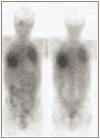Recent trends in soft-tissue infection imaging
- PMID: 19187804
- PMCID: PMC2657227
- DOI: 10.1053/j.semnuclmed.2008.10.005
Recent trends in soft-tissue infection imaging
Abstract
This article discusses the current techniques and future directions of infection imaging with particular attention to respiratory, central nervous system, abdominal, and postoperative infections. The agents currently in use localize to areas of infection and inflammation. An infection-specific imaging agent would greatly improve the utility of scintigraphy in imaging occult infections. The superior spatial resolution of (18)F-fluorodeoxyglucose positron emission tomography ((18)F-FDG-PET) and its lack of reliance on a functional immune system, gives this agent certain advantages over the other radiopharmaceuticals. In respiratory tract infection imaging, an important advancement would be the ability to quantitatively delineate lung inflammation, allowing one to monitor the therapeutic response in a variety of conditions. Current studies suggest PET should be considered the most accurate quantitative method. Scintigraphy has much to offer in localizing abdominal infection as well as inflammation. We may begin to see a gradual increase in the usage of (18)F-FDG-PET in detecting occult abdominal infections. Commonly used modalities for imaging inflammatory bowel disease are scintigraphy with (111)In-oxine/(99m)Tc-HMPAO labeled autologous white blood cells. The literature on central nervous system infection imaging is relatively scarce. Few clinical studies have been performed and numerous new agents have been developed for this use with varying results. Further studies are needed to more clearly delineate the future direction of this field. In evaluating the postoperative spine, (99m)Tc-ciprofloxacin single-photon emission computed tomography (SPECT) was reported to be >80% sensitive in patients more than 6 months after surgery. FDG-PET has also been suggested for this purpose and may play a larger role than originally thought. It appears PET/computed tomography (CT) is gaining support, especially in imaging those with fever of unknown origin or nonfunctional immune systems. Although an infection-specific agent is lacking, the development of one would greatly advance our ability to detect, localize, and quantify infections. Overall, imaging such an agent via SPECT/CT or PET/CT will pave the way for greater clinical reliability in the localization of infection.
References
-
- Rennen HJ, Boerman OC, Oyen WJ, et al. Imaging infection/inflammation in the new millennium. Eur J Nucl Med. 2001;28:241–252. - PubMed
-
- Boerman OC, Rennen H, Oyen WJ, et al. Radiopharmaceuticals to image infection and inflammation. Semin Nucl Med. 2001;31:286–295. - PubMed
-
- Tulchinsky M, Peters AM. Leukocyte receptor-binding radiopharmaceuticals for infection and inflammation scintigraphy. J Nucl Med. 2005;46:718–721. - PubMed
-
- Thakur ML, Lavender JP, Arnot RN, Silvester DJ, Segal AW. Indium-111-labeled autologous leukocytes in man. J Nucl Med. 1977;18(10):1014–21. - PubMed
-
- Vinjamuri S, Hall AV, Solanki KK, et al. Comparison of 99mTc infecton imaging with radiolabelled white-cell imaging in the evaluation of bacterial infection. Lancet. 1996;347:233–235. - PubMed
Publication types
MeSH terms
Grants and funding
LinkOut - more resources
Full Text Sources
Other Literature Sources
Medical



